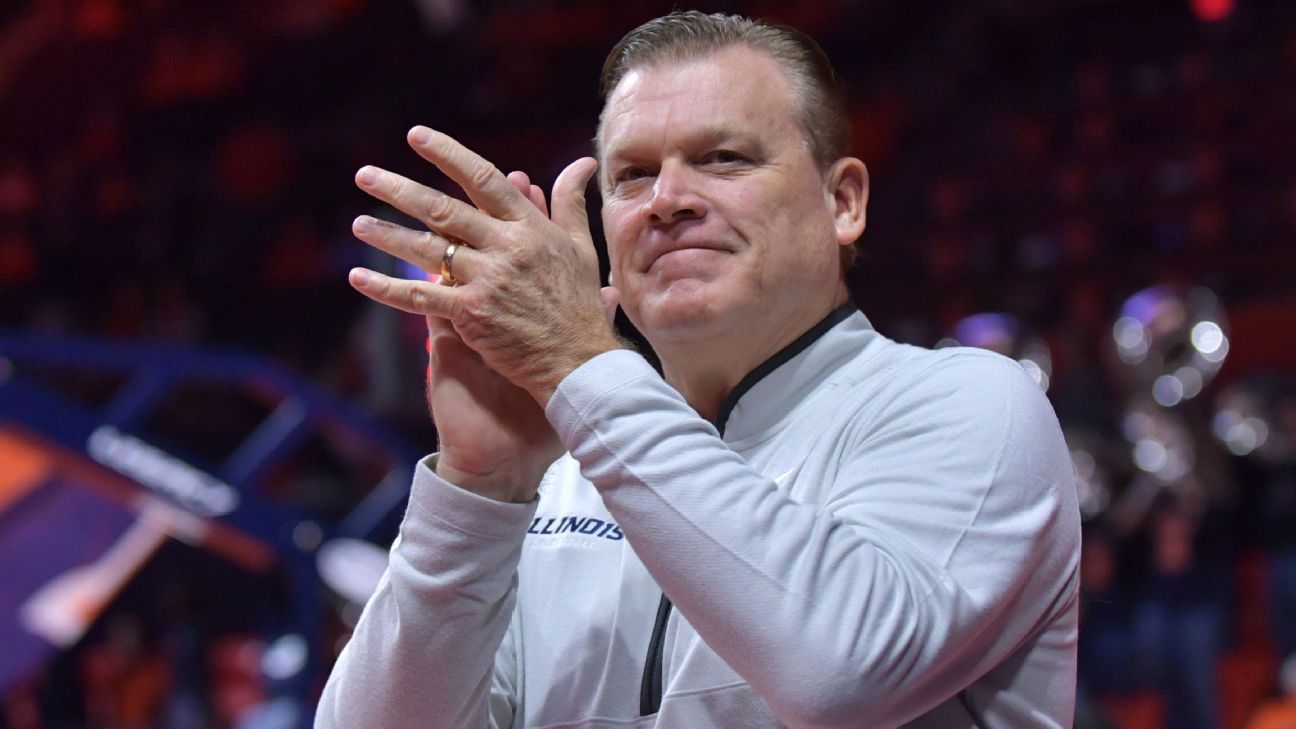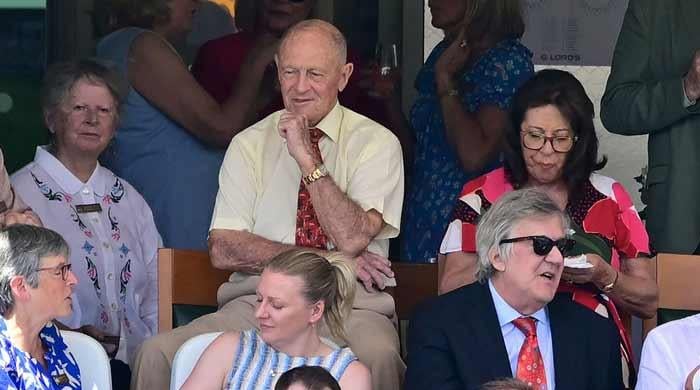Sports
Wetzel: Why college basketball coaches can watch more football in 2025

The University of Illinois football team plays host to top-ranked Ohio State on Saturday, assuring a sellout crowd and a frenzied campus atmosphere. The weather in Champagne is expected to be perfect — mostly sunny and in the 70s.
“Chamber of Commerce stuff,” said Brad Underwood, the school’s basketball coach.
In past years, Underwood would have set up a massive recruiting weekend, trying to convince every possible high school prospect to see U of I at its best. The early signing period, after all, is just five weeks away.
This year? No official visits, just a couple of local players who will drive over on their own.
“I’m just choosing not to do it,” Underwood said. “I’m not wasting the time or the dollars.”
Welcome to the fall, where college basketball recruiting season is in semi-hibernation.
The recruiting calendar has shifted for myriad reasons. The tendency of coaches to favor experienced players from the transfer portal has lowered the heat on landing high school stars. Meanwhile, top players are holding out for more certainty and what they hope are higher monetary offers in the spring.
But the trend is compounded this year by uncertainty over a proposed NCAA change that would provide all athletes five years of eligibility over a five-year span, dubbed the “5-in-5 Rule.” The goal is to end redshirts, arbitrary waiver decisions and lawsuits over eligibility.
The problem is, it’s unclear if the rule will pass, let alone when it will be implemented. The NCAA process is notoriously slow, and though a source with knowledge of the situation tells ESPN that it won’t happen this academic year, there has been no official statement. In an age of rapid and dramatic change, coaches remain wary.
If the 5-in-5 rule does happen, then suddenly almost every current college senior would have an extra year of eligibility, causing a logjam for incoming freshmen.
Since coaches have no idea how many players can return, they also don’t know how many new players they might need.
And if they need new players, will they add from a portal list of experienced 22-year-olds rather than turn to unproven high schoolers? That doesn’t factor in how much revenue share money and NIL opportunities need to be allocated to keep your roster.
Essentially, the entire sport is flying somewhat blind on how to build a roster for the 2026-27 season. Illinois might need significant work. Or it might need almost no one (it has two high school players committed).
“No one knows what is coming or what to do,” said Underwood, who has led Illinois to five consecutive NCAA tournament appearances.
That also extends in the other direction. Current players are more cautious because they can’t project what they’re walking into, from playing time to available money.
It’s one reason, even with the Nov. 15 early signing period approaching, only 16 of ESPN’s top 50 recruits (and just three of the top 15) are committed to a school.
“In the past, a high school recruit would say, ‘This is how I would fit in on the roster,’ but that is gone now. You don’t know the roster for next year,” said Paul Biancardi, ESPN’s national director of recruiting. “With the portal kids coming or leaving, you don’t know what the roster is going to be.”
Everything has been pushed to the spring, where Underwood expects “total chaos.”
His frustration isn’t with the proposed rule — he says he supports 5-in-5 as long as it ends the waivers and legal cases. And Underwood, despite being a coach of 38 years, isn’t grumbling about the good old days. He likes most of this new era.
“I’m tired of all the complaining by coaches,” Underwood said. “I think … [college] basketball is the best it’s ever been. There is so much top-end talent in the game. I think the game is ready to explode.”
He would just like some clarity on how to plan for next year.
“We just need to know what it is going to be,” he said.
If a fifth year eventually comes, many high school prospects could be pushed to the mid-major level. That, too, can be a strategy. If you are, say, a top-100 recruit, why sign with a major team to play a limited role, when you can go to a mid-major and prove yourself?
“That’s an opportunity for kids,” Underwood said. “Go build your brand as a double-digit scorer.”
Basically, no one is sure what path to take.
“It’s really fascinating how it’s changed, how coaches go about it, the money, the transfer portal,” Biancardi said. “Everything is different.”
Not all bad, just different. Underwood says it used to be “hair on fire” this time of year. This September, though, he went out just one day to recruit. April and May will be crazy, but he has more time to connect with “the guys I’m going to try to win with this winter.”
And on what otherwise would have been a busy fall recruiting weekend, he might get to settle in and watch the football game.
Sports
The Commanders are coming up empty on this season’s ‘luck dashboard’
After benefiting from good fortune in 2024, Washington is among the NFL’s unluckiest teams in 2025, according to metrics compiled by an NFL data scientist.
Source link
Sports
How Nick Saban and ESPN tried to help Lane Kiffin coach two teams at once
Kiffin wanted to stay at Mississippi through the College Football Playoff even after taking the job at LSU. That only made sense on television.
Source link
Sports
Geoffrey Boycott advises England to ‘use brains’ for Ashes remainder

Legendary England batter Geoffrey Boycott on Monday advised the Ben Stokes-led side to adopt a more strategic and thoughtful approach ahead of the second Ashes Test against Australia, scheduled for Thursday in Brisbane.
England suffered an agonising eight-wicket defeat in the series opener in Perth, which lasted less than two days, the first of which was dominated by the touring side as they had reduced the hosts to 123/9 after accumulating 172 all out.
The visitors now face another gruelling challenge in the blockbuster series as they take on the Baggy Greens in a pink-ball Test, in which the hosts boast a dominant record, having lost just one out of their previous 14 appearances, but Boycott, who has won Ashes both in England and Australia, believes that the Three Lions can win the upcoming game by adopting a calculated strategy.
He, however, warned England batters of self-destruction, advising them to “use their brains” and decide whether to attack or hold back after analysing the situation.
“But it doesn’t help our chances of success if Ben Stokes keeps encouraging our batsmen to attack, attack with one finger hovering over the self-destruct button,” Boycott wrote in his Daily Telegraph column.
“Nobody is asking the players to stop being positive because they have given us some marvellous, thrilling and entertaining cricket. All we ask is for them to use their brains and realise there are times when they should throttle back and be aware of situations and bat accordingly,” he added.
Boycott, who represented England in 108 Tests and 36 ODIs, also slammed Stokes for his comments in which he referred to former cricketers as “has-beens” but expressed satisfaction over the all-rounder’s partial apology.
“To call past players ‘has-beens’ was disrespectful, especially as some of those ‘has-beens’ played in teams that won the Ashes in England and Australia,” Boycott wrote.
“I am glad Ben has half apologised, saying it was a slip of the tongue, because none of this team has won the Ashes in Australia. Get the job done, because then you don’t need to say anything and you can bask in all the glory coming your way.”
-

 Sports1 week ago
Sports1 week agoWATCH: Ronaldo scores spectacular bicycle kick
-

 Entertainment1 week ago
Entertainment1 week agoWelcome to Derry’ episode 5 delivers shocking twist
-

 Politics1 week ago
Politics1 week agoWashington and Kyiv Stress Any Peace Deal Must Fully Respect Ukraine’s Sovereignty
-

 Business1 week ago
Business1 week agoKey economic data and trends that will shape Rachel Reeves’ Budget
-

 Politics1 week ago
Politics1 week ago53,000 Sikhs vote in Ottawa Khalistan Referendum amid Carney-Modi trade talks scrutiny
-

 Tech6 days ago
Tech6 days agoWake Up—the Best Black Friday Mattress Sales Are Here
-

 Fashion1 week ago
Fashion1 week agoCanada’s Lululemon unveils team Canada kit for Milano Cortina 2026
-

 Tech1 day ago
Tech1 day agoGet Your Steps In From Your Home Office With This Walking Pad—On Sale This Week





